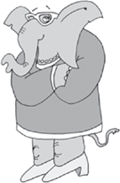Index
A
arrowhead exercise, 78
authenticity, 52–53
B
behavior, changing, 84
beliefs, testing and revising, 48–50
Biano, Ochwiay, 82
Bird by Bird (Lamott), 44
blind men and elephant metaphor, 32
Brickman, Philip, 126
C
Carnegie, Dale, 127
Cass, Lewis, 52–53
CCC (change, consequence, contract) model, 84
change management, 45. See also flexibility.
charisma, 122–125
coaching styles, 73–75
cognitive dissonance, 71–72
communication
conflicts vs. connections, 25–27
Down To It questions, 103
manager as psychologist, 98–99
neutral statements, 62
outcome-based questions, 102–103
problem-based questions, 101–102
thinkers vs. feelers, 60–65
tone, 103
verbal clues, 60–65
communication style
customizing, 60
flexibility, 57
meeting midway, 59
rapport with others, 57
reframing scenarios, 59
conclusions, jumping to, 58
conflicts vs. connections, 25–27
consensus, 76–77
consumer advocacy example, 103
control over others, 45–47
crisis hotline example, 100
D
decision making skills, thinkers vs. feelers, 38–39
deletions, 136
distortions, 136–137
doing good vs. feeling good, 74
Down To It questions, 103
elephant and blind men metaphor, 32
emotions in the workplace. See feelings.
envelopes exercise, 116–117
ERSA (expectations, relinquish, support, accountable), 86
executive presence, 122–125
extroverts. See also personality types.
correlation to thinkers and feelers, 110
as managers, 111–116
managing, 117–119
myths about, 117–119
vs. extroverts, 111
in the workplace, 116–117
F
feedback guidelines, 83–93
feelers. See also personality types; thinkers.
characteristics as managers, 24
decision making skills, 38–39
description, 23–25
firing people, 104–105
gender stereotypes, 39–42
history of, 32–35
language, decoding, 27
leadership style, 17
Native American perspective, 82
on the thinking continuum, 23–25
values, 24
verbal clues to identifying, 60–65
visual clues to identifying, 65–66
vs. thinkers, 28
work environment, 65–66
feel-good behaviors, 73–75
feeling good vs. doing good, 74
feelings
Down To It questions, 103
importance of, 34–35
instincts, 144–148
manager as psychologist, 98–99
outcome-based questions, 102–103
problem-based questions, 101–102
turning off at will, 38
filtering exercise, 106
firing people, 104–105
flexibility
meeting midway, 59
rapport with others, 57
reframing scenarios, 59
while being yourself, 56–60
Frankl, Victor, 50
Frazer, J.J., 127
Fs. See feelers.
G
garbage recycling, management example, 122–123
gender stereotypes, thinkers vs. feelers, 39–42
generalizations, 134–135
gut feelings, 144–148
H
Hawthorne study, 139–141
I
ID check, example of flexibility, 59
impostor phenomenon, 52
The Impostor Phenomenon (Clance), 52
influence vs. control, 46–47
intentions vs. interpretation, 10–13
introverts. See also personality types.
correlation to thinkers and feelers, 110
as managers, 111–116
managing, 117–119
myths about, 117–119
vs. extroverts, 111
in the workplace, 116–117
J
jumping to conclusions, 58
Juster, Norton, 7
K
kangaroos, approaching, 10–13
kitchen design, management example, 123–124
L
Lamott, Anne, 44
language of thinkers and feelers, decoding, 27
leadership, 13–14. See also managing.
leadership style, thinkers and feelers, 17
leading by example
the lost presentation example, 53
mind management, 137–139
Southwest Airlines example, 137–139
learning, modalities, 8–9
logotherapy, 50–51
loneliness, 70–79
lottery, winning, 126–127
M
management as a career
achieving success, 7–8
change management, 45
declining, 49
effect on work relationships, 70–79
loneliness, 70–79
motivational forces, 50–51
satisfaction with, 6
self-demotion, 49
sense of futility, 7
stress management, 44–45
management by walking around, 115
manager as psychologist, 98–99
managing
definition, 5
deliverables, 83
leadership, 13–14
reasons for disliking, 6
supervision, 13–14
with your brain. See mind management.
Man’s Search for Meaning (Frankl), 50
materialism, as motivation, 126–127
MBTI (Myers-Briggs Type Indicator). See also personality types.
definition, 16–17
gender stereotypes, 39–42
meaning in life, 50–51
Memories, Dreams, Reflections (Jung), 82
men, thinkers vs. feelers stereotypes, 39–42
mind management
deletions, 136
distortions, 136–137
generalizations, 134–135
leading by example, 137–139
NLP (neuro-linguistic programming), 134–137
observer effects, 139–141
overview, 130–131
self-assessment, thought habits, 132–133
mind reading, 48–50
money, as motivation, 126–127
motivational forces
feedback, 83–93
management as a career, 50–51
materialism, 126–127
money, 126–127
observer effects, 139–141
positive reinforcement, 87
positive statements, 107
purpose and meaning in life, 50–51
winning the lottery, 126–127
multivoting, 76–77
N
NASA team-building exercise, 146–147
Native American perspective on thinkers and feelers, 82
neutral statements, 62
NLP (neuro-linguistic programming), 134–137
O
observer effects, 139–141
outcome-based questions, 102–103
P
PANIC exercise, 67
personality types. See also extroverts; feelers; introverts; thinkers.
continuum of, 22–23
identifying. See MBTI (Myers-Briggs Type Indicator).
self-assessment, 19–21
The Phantom Tollbooth (Juster), 7
positive reinforcement, 87
positive statements, 107
problem-based questions, 101–102
PROD (problem, result, observe, different), 92
psychologist, management role, 98–99
psychotherapy for managers, 50–51
purpose in life, 50–51
Q-tip (Quit Taking It Personally), 34–35
R
rapport with others, 57
reframing scenarios, 59
rules for management
S
self awareness, 53–54
self-assessment
personality types, 19–21. See also MBTI (Myers-Briggs Type Indicator).
thought habits, 132–133
self-demotion, 49
self-doubt
authenticity, 52–53
impostor phenomenon, 52
self awareness, 53–54
words vs. actions, 52–53
shoe shine stand, management example, 124–125
sociopaths in the workplace, 93–94
Southwest Airlines, leadership example, 137–139
stress management, 44–45
suicide prevention hotline example, 100
supervision, 13–14. See also managing.
T
team building
establishing common ground, 67
examples, 9–13
NASA exercises, 146–147
PANIC exercise, 67
thinkers. See also feelers; personality types.
characteristics as managers, 24
decision making skills, 38–39
on the feeling continuum, 23–25
firing people, 104–105
gender stereotypes, 39–42
history of, 36–39
language, decoding, 27
leadership style, 17
Native American perspective, 82
values, 24
verbal clues to identifying, 60–65
visual clues to identifying, 65–66
vs. feelers, 28
work environment, 65–66
thinking outside the box, 78
tone, role in communication, 103
Ts. See thinkers.
V
values, thinkers vs. feelers, 24
vocabulary, thinkers vs. feelers, 26–27, 64
W
wantitude, 28
women, thinkers vs. feelers stereotypes, 39–42
words vs. actions, 52–53
work environment, thinkers vs. feelers, 65–66
work relationships, manager vs. managed, 70–79

